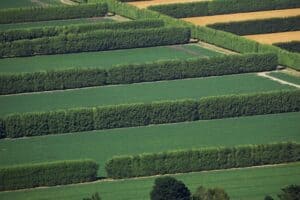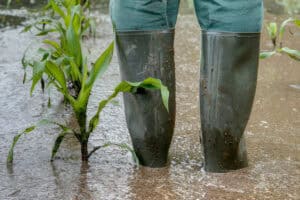Farmers have considerable hurdles in protecting their crops from the potentially disastrous impacts of severe rains. Excessive rainfall can cause soil erosion, root damage, nutrient leaching, and the spread of plant diseases. However, gardeners use several strategies and techniques to reduce these risks and protect their crops with the help of Cultiv’s products for soil.
We are committed to assisting yield growth with our CULTIV range of products, which will help feed the world. After being exposed to the most impoverished and disadvantaged areas in South America, we decided to make a difference by assisting subsistence farmers to increase their production and yields so that they can better care for their families and communities.
Here’s a comprehensive look at how to protect crops from heavy rain:
Implement Proper Drainage Systems
Effective drainage is critical to preventing waterlogging and ground damage. Gardeners frequently dig ditches, install tile drainage systems, and utilize a raised bed to redirect excess water away from crop areas. These devices maintain the ground’s structural integrity and prevent root systems from rotting by minimizing extended water saturation near the waterlogged plants.
Utilize cover crops
Clover, rye, and alfalfa are significant row covers for specific crops and other delicate plants that help against soil and root damage under wet conditions. These legumes and grasses are grown primarily as a type of mulch, more of a protection for the land, not for harvesting. They help prevent physical damage to certain plants and avoid root rot by reducing the impact of steady rainfall on the ground surface and improving land structure and root system. Furthermore, cover crops can improve water penetration and reduce runoff and reduce water pooling, which can cause crop damage.
Implement Conservation Tillage Practices
Conservation tillage, which includes no-till and reduced-till farming, promotes topsoil stability and energizes organic matter. These methods lessen damage risk while improving water infiltration and reduce or prevent flooding. Residue from different crops left on the field surface operates as a protective layer, absorbing the impact of directly hitting heavy rains and slowing the rate at which water flows across the land.
Build Terraces
Ditches dug on terraces are an excellent way to control water flow and avoid topsoil damage in hilly or inclined terrain. Terracing is the process of building stepped levels on a slope to decrease water runoff and allow water to penetrate deeper into the land. This strategy minimizes soil deterioration and optimizes the use of rainwater for crop growth.
Build Windbreaks and Shelterbelts
Windbreaks and shelterbelts, usually made up of trees and shrubs, are planted around fields to reduce the force of strong winds and rain. These barriers slow the rate of water runoff and serves to protect plants from physical harm caused by wind-driven rain. Furthermore, they can store snow, which gradually melts and offers crops a more controlled water supply and improve air circulation.
Use Mulch
Mulching is the process of spreading materials such as straw, wood chips, or susceptible covers over land. It reduces soil erosion, keeps soil moist, and protects plants and flowers against rain damage. Organic mulches also disintegrate over time, providing essential nutrients to the topsoil and plant roots to improve its structure.
Install Raised Beds
Raised beds are a great option for small-scale plant growers and gardeners. They increase drainage by raising the garden area and lowering the risk of waterlogging. This approach prevents crops and plants from becoming buried in standing water, which can cause root infections and poor plant health.
Employ Controlled Traffic Farming (CTF)
CTF entails limiting machinery movement to particular lanes in the field, reducing land compaction, and preserving soil structure. This method helps precipitation absorb into the crop bed more effectively, decreasing runoff and erosion. If the land is kept healthy, crops or plants can endure heavy rainfall more easily
Enhance Land Health
Healthy topsoil with a strong structure and organic plants may absorb and hold more water, mitigating the effects of severe rainfall. Farmers improve land health by using crop rotation, organic amendments, and avoiding over-tilling. Healthy topsoil functions like a sponge, absorbing excess moisture and gradually releasing it to crops.
Monitor Weather and Using Forecasts
Thanks to modern technologies, plant growers may now receive accurate weather forecasts and real-time data. Gardeners aware of severe rains might take preventive precautions such as temporarily covering sensitive crops, altering irrigation schedules, and upgrading drainage systems.
Conclusion
Farmers face tremendous problems from heavy rains but may efficiently safeguard their crop health by combining traditional approaches with new technologies. Some use various measures to reduce the consequences of heavy rainfall, including adequate drainage systems, cover plants, conservation tillage, building terraces, and improving land health. Garden enthusiasts who use these approaches can ensure that their other crops or stake plants are resilient and productive in the face of unfavorable weather conditions.
Get Started with CULTIV Today!
With CULTIV’s specialized solutions, you can protect your crops while increasing farm productivity. Visit our website or call us today to find out how we can help you protect your harvest from excessive rains or heavy winds. Don’t wait for the next storm; take action with CULTIV to ensure your crops grow all year.
Your crops deserve the best protection. Choose CULTIV and cultivate success!




